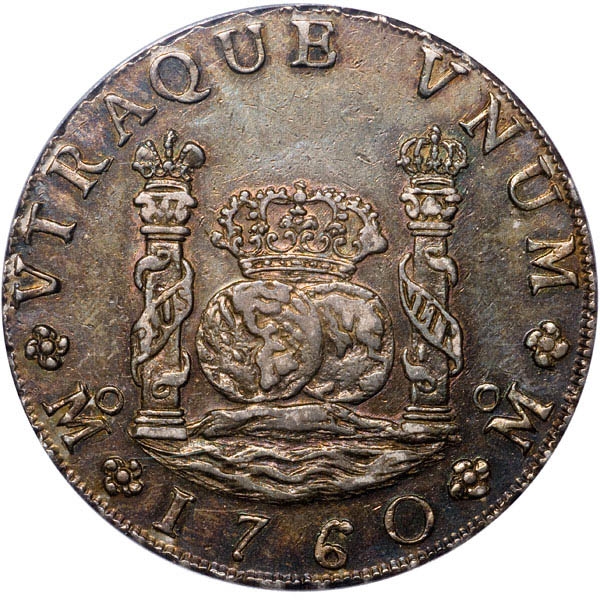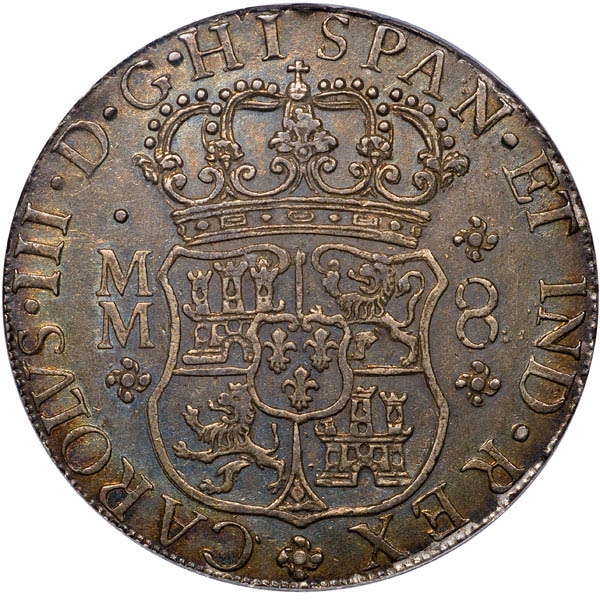Options
Foreign coins that circulated in Early America
 Boosibri
Posts: 12,391 ✭✭✭✭✭
Boosibri
Posts: 12,391 ✭✭✭✭✭
As many will know, many foreign coins were legal tender in America until 1857. Have to start this thread with a Spanish Milled Dollar:




0
Comments
MLC should sniff this thread out soon enough.
Looking for Top Pop Mercury Dime Varieties & High Grade Mercury Dime Toners.
Hi Al!
Latin American Collection
John Payne sterling mug, 1774
8 reale, 4 reale, two 2-reales
Essex Journal & New Hampshire Packet, 1791
--Severian the Lame
Here are some notes from various sources about the Pistareen and its importance in Colonial America.
- The Journals of the Continental Congress for October 7, 1775 note:
"S. Adams understands that the works at Cambridge were done without any allowance but that General Washington has ordered that, for future works, they be allowed half a pistareen a day."
- The pistareen was a debased Spanish coin of the early 1700s. Not popular in Spain, it found ready acceptance in the colonies where hard money and small change were needed. The pistareen varied from 84 to 96 grains, and from. 8125 to. 42 fine. It took five pistareens to make a Spanish dollar.
- Even before the Declaration of Independence, the united colonies of America considered issuing their own money. The initial proposals were for a dollar. A report of January 3, 1776, discussed silver dollars and a report of April 3, 1776, recommended paper dollars. The first mention of the 20-cent piece was in a report by Gouvenour Morris to Congress on May 3, 1779. Outlining his proposals for American coinage, he wrote, "we need a pistareen."
- A detailed series of four reports dated April 8 through 12, 1786, and entered on April 20, 1786, included the double dime or pistareen in its recommendations. Appended to the second report was a summary by Samuel Osgood and Walter Livingston of Thomas Jefferson's "Notes on the Establishment of a Money Unit and on a Coinage for the United States." Again, the plan called for a "fifth or Pistareen containing 73 Grains of pure Metal." The treasury committee amended the recommendation, boosting the double dime to 75.14 grains to be in line with their call for a heavier dollar.
- All of this took place under the Articles of Confederation. When the present constitution was adopted, the new federal government opted for a dime and a quarter dollar and ignored the fifth. However, the Spanish pistareen commonly circulated in the United States until 1827. At that time, it was recognized by law that the pistareens in circulation were so worn that their legal value could not be more than 17 cents.
- A quote from Erik Goldstein, Curator of Mechanical Arts and Numismatics at Colonial Williamsburg: A pistareen is a very important coin. It’s not a very rare or a very valuable coin, but it’s important because they were shipped to the American colonies in huge quantities in the 18th century. Because of what archaeologists have found within Williamsburg, I can pretty much state with some certainty that the pistareen was the most common silver coin circulating in Revolutionary War period Virginia.
1725-S J Spain 2R, Pistareen, Philip V Type, Struck at the Seville mint, MS65 [PCGS]
--Severian the Lame
As many will know, many foreign coins were legal tender in America until 1857. Have to start this thread with a Spanish Milled Dollar:
That's a wonderful example, Boosibri!
Lance.
1683 Charles II
The 1684 is fairly well worn, but a very rare date that is one of my best $3 junk box finds in a long time - it is worth much more. They were struck very late in the reign of Charles II and then minting stopped when Charles II died.
A comparatively short reign, James II was toppled from the Crown by the "Glorious Revolution" in 1688.
But James II didn't go away so quickly and his forces continued to fight in Ireland until 1691. This halfpenny with the retrograde N in Hibernia was struck over earlier gunmoney.
George I gave the letters patent for striking coinage for Ireland and America to William Wood in 1722 - effectively authorising the "Hibernia halfpennies" that would become the scourge of the American colonies, prompting some such as Massachusetts Bay to ban their usage.
Thanks for the Pistareen history MLC..... The coins from the 1600's are impressive too.
Cheers, RickO
Turkish Egypt Zeri Mahbubs or Sultanis.
I guess that the attitude of colonial merchants was "if it's gold we'll take it".
Ottoman Egypt Zeri Mahbub Sultan Mahmud I AH 1143 (AD 1730)
Gold, 20mm, 2.61gm, KM-221, no regnal year
Ottoman Egypt Zeri Mahbub Sultan Mustafa III AH 1171 (AD 1757)
Gold, 20mm, 2.33gm, KM-334, no regnal year
The Mysterious Egyptian Magic Coin
Coins in Movies
Coins on Television
This is a rare and well-known British counterfeit Halfpenny that is always very popular because it was engraved totally backwards (well, really it was engraved not-backwards so everything is a mirror image). It is referred to as the "Lionhead" type. Only about 8-10 are known today.
This one is another well-known Irish counterfeit halfpenny. This date must have been extremely comical back in the late 1700s! (200+ years in the future). This piece was obviously meant to be dated in 1769 but a die engraving error gives us this wonderfully fun date of 1969. Another very rare piece, this one was from the Mike Ringo Collection sold by Stacks in 2008.
and purchased intact by a friend of mine:
Tom
A few pieces of 8 from my collection:
8 Reales Madness Collection
This will be a nice companion to the Pine Tree shilling I don't have yet.
Keeper of the VAM Catalog • Professional Coin Imaging • Prime Number Set • World Coins in Early America • British Trade Dollars • Variety Attribution
Latin American Collection
Here's my shilling (1640)
My YouTube Channel
My YouTube Channel
James Stamp sterling mug, 1775
John Payne sterling mug, 1774
8 reale, 4 reale, two 2-reales
Essex Journal & New Hampshire Packet, 1791
cool.
My YouTube Channel
Just three owners over the last 135 years!
Wow!
Latin American Collection
Expect expanded coverage of this topic in the next Redbook.
Very good news!
Tom
Just three owners over the last 135 years!
Wow!
Where's the 1/2 escudo?
Tom
Just three owners over the last 135 years!
Wow!
Where's the 1/2 escudo?
While the Eliasberg Collection included a number of 1/2 escudos, there were none of the matching Carolus IIII type.